High Reliability Coaxial Microwave Switches
Radiall Inc.
Paris, France and Stratford, CT, USA
An innovative new system has been designed for constructing electromechanical coaxial RF switches with increased long-term reliability. The Radiall Modular System for Electromechanical Switches (RAMSES) is a patented concept that enables microwave coaxial switches to be produced with a typical operating life of 10 million cycles while suffering no decrease in contact resistance reliability over time. In addition, the unique internal construction makes the switches cost-competitive with traditional switches.
RAMSES units are available for frequency operation to 18 GHz and are fitted with either type N, SMA or TNC connectors. Switching time is 5 ms (typ) and power consumption is 100 mA at 28 V DC. Single-pole switch configurations with up to 12 throws are available, as well as SPDT and DPDT versions.
Friction Effects
The unique design of RAMSES is based on the reduction of friction, which minimizes particle deposits that can interfere with the transmission of lower frequency signals (up to 3 GHz). This particle elimination effect is particularly important for telecommunications applications that are currently in the 900 MHz and 2 GHz regions. In addition, the design involves fewer components than other microwave switches, making it easier and quicker to assemble. These savings directly relate to lower cost for improved performance.
Many of the existing coaxial electromechanical switches also are able to function mechanically for 10 million operations, but the reliability and quality of the electrical contact can seriously degrade during that lifetime. In general, these traditional switches operate by moving a rectangular switching blade section inside a rectangular cavity. The blades are linked with pushers constructed of dielectric material that travel inside an access hole between the RF cavity and switch actuator. The pushers are directed by dielectric material guides. These dielectric parts rub on the blades and inside the access hole and generate isolating particles in the RF cavity that pollute the electrical contacts and ultimately cause running defects.
Figure 1 shows the buildup of minute dielectric particles on a set of conventional switch contacts after one million cycles. These defects are not particularly noticeable at very high frequencies since the contact is established by a capacitive effect. However, the insertion loss of the contacts increases considerably at lower frequencies (3 GHz and below).
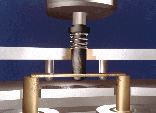
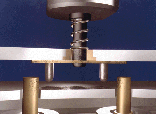
A New Actuator Configuration
To eliminate this problem of increased insertion loss in the contacts, RAMSES  devices incorporate a patented system comprising two parallel blades suspended from a bearer, which enables the guiding and positioning of the commutation blades to be accomplished entirely outside the RF cavity. These blades impose a rectilinear motion on the switching pusher, suppressing both friction and the production of particles inside the RF cavity. The unique system is extremely small and can be used in all of the RAMSES series switches. Figure 2 shows a cutaway view of a RAMSES coaxial switch displaying the actuator mechanism.
devices incorporate a patented system comprising two parallel blades suspended from a bearer, which enables the guiding and positioning of the commutation blades to be accomplished entirely outside the RF cavity. These blades impose a rectilinear motion on the switching pusher, suppressing both friction and the production of particles inside the RF cavity. The unique system is extremely small and can be used in all of the RAMSES series switches. Figure 2 shows a cutaway view of a RAMSES coaxial switch displaying the actuator mechanism.
A second improvement involves a new rectilinear actuator design using high energy magnets and a patented magnetic circuit that significantly improves switching performance in relation to its size. The system is used in the production of both fail-safe and latching actuators, depending on how it is applied in the switch. The actuator system also produces sticking forces that far exceed those of traditional actuators; that is, either 500 g locking forces or 300 to 800 g current forces for a power consumption of 100 mA at 28 V. The new actuator has the added advantage of very low magnetic leakage, allowing actuators to be used in close proximity to one another without performance degradation. Finally, the use of a dry, solid lubricant and the control of friction areas produce an actuator life expectancy of over 50 million operations without defect over a –55° to +85°C temperature range.
Switch Performance
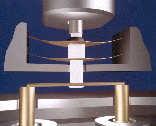 RAMSES series switches have successfully survived tests of 10 million switching temperature cycles from –55° to +85°C while demonstrating good contact resistance stability. Visual inspection of these switches after testing has indicated that the RF lines were free of much of the contamination found during similar tests on traditional switches. Figure 3 shows a set of
RAMSES series switches have successfully survived tests of 10 million switching temperature cycles from –55° to +85°C while demonstrating good contact resistance stability. Visual inspection of these switches after testing has indicated that the RF lines were free of much of the contamination found during similar tests on traditional switches. Figure 3 shows a set of 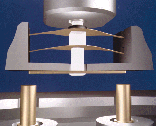 RAMSES contacts after five million cycles. (Note the absence of dielectric particle residue.) A comparison of the actual measured contact resistance obtained from monitoring both conventional and RAMSES switches during several hundred toggles on parts that
RAMSES contacts after five million cycles. (Note the absence of dielectric particle residue.) A comparison of the actual measured contact resistance obtained from monitoring both conventional and RAMSES switches during several hundred toggles on parts that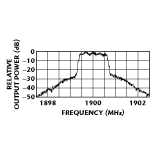 have already been actuated one million cycles is shown in Figure 4 . Although the conventional switch may not be considered a failure, its contact resistance has become unstable, thus degrading its reliability.
have already been actuated one million cycles is shown in Figure 4 . Although the conventional switch may not be considered a failure, its contact resistance has become unstable, thus degrading its reliability.
The switches are available in various configurations as miniatures and standards in frequency ranges from DC to 18 GHz. The switching sequence is break before make with either normally open or latching modes. Actuator voltages are 12 or 28 V DC. The switches can handle 1.5 kW of peak power (1 ms at 1000 PRF). Switching time is 15 ms (max) under normal voltage at 25°C. RF connectors are typically type N or SMA and the actuator terminals are solder pins. For terminated models, the termination is 50 W ±5 percent at 1 W. The operating temperature is –40° to +85°C.
The maximum SWR for a typical multiposition DC-to-18-GHz switch ranges from 1.2 at 3 GHz to 1.8 at 18 GHz, depending on the number of positions. Insertion loss varies from 0.2 to 0.7 dB (max), and minimum isolation is from 80 dB at 3 GHz to 60 dB at 18 GHz. Individual data sheets as well as price and delivery information are available from the manufacturer.
Radiall Inc.,
Paris, France
(33) (0) 1 49 35 35 35
or Stratford, CT
(203) 380-9800
